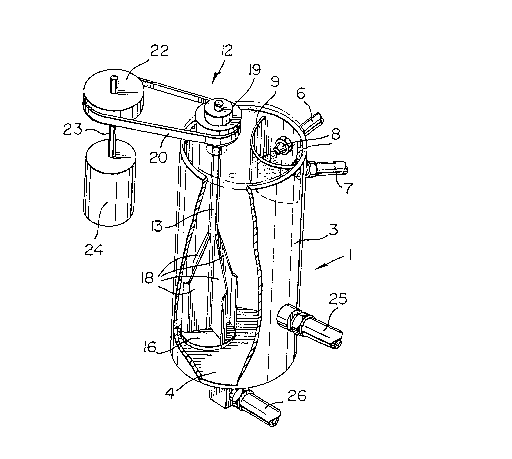Some of the information on this Web page has been provided by external sources. The Government of Canada is not responsible for the accuracy, reliability or currency of the information supplied by external sources. Users wishing to rely upon this information should consult directly with the source of the information. Content provided by external sources is not subject to official languages, privacy and accessibility requirements.
Any discrepancies in the text and image of the Claims and Abstract are due to differing posting times. Text of the Claims and Abstract are posted:
| (12) Patent Application: | (11) CA 2055369 |
|---|---|
| (54) English Title: | MIXING APPARATUS |
| (54) French Title: | APPAREIL SERVANT A MELANGER |
| Status: | Deemed Abandoned and Beyond the Period of Reinstatement - Pending Response to Notice of Disregarded Communication |
| (51) International Patent Classification (IPC): |
|
|---|---|
| (72) Inventors : |
|
| (73) Owners : |
|
| (71) Applicants : |
|
| (74) Agent: | |
| (74) Associate agent: | |
| (45) Issued: | |
| (22) Filed Date: | 1991-11-13 |
| (41) Open to Public Inspection: | 1992-05-14 |
| Examination requested: | 1992-05-26 |
| Availability of licence: | N/A |
| Dedicated to the Public: | N/A |
| (25) Language of filing: | English |
| Patent Cooperation Treaty (PCT): | No |
|---|
| (30) Application Priority Data: | ||||||
|---|---|---|---|---|---|---|
|
ABSTRACT OF THE DISCLOSURE
Conventional devices for mixing liquids include a
container and some form of stirrer for one stage mixing. A
two stage mixer for producing a homogeneous emulsion includes
a container, a stirrer, and a preliminary mixer in the form
of an arcuate plate defining a target above the stirrer. The
two liquids are injected into the container through orifices,
which are suitably oriented that the liquid streams converge
to meet at the target. Thus, preliminary mixing of the
liquids occurs at the target, and the liquids fall to the
bottom of the container where the mixing process is completed
by the stirrer.
Note: Claims are shown in the official language in which they were submitted.
Note: Descriptions are shown in the official language in which they were submitted.

2024-08-01:As part of the Next Generation Patents (NGP) transition, the Canadian Patents Database (CPD) now contains a more detailed Event History, which replicates the Event Log of our new back-office solution.
Please note that "Inactive:" events refers to events no longer in use in our new back-office solution.
For a clearer understanding of the status of the application/patent presented on this page, the site Disclaimer , as well as the definitions for Patent , Event History , Maintenance Fee and Payment History should be consulted.
| Description | Date |
|---|---|
| Inactive: IPC expired | 2022-01-01 |
| Inactive: IPC expired | 2022-01-01 |
| Revocation of Agent Requirements Determined Compliant | 2020-09-01 |
| Inactive: IPC from MCD | 2006-03-11 |
| Inactive: Inventor deleted | 2002-09-18 |
| Inactive: Inventor deleted | 2002-09-18 |
| Application Not Reinstated by Deadline | 1996-05-13 |
| Time Limit for Reversal Expired | 1996-05-13 |
| Inactive: Adhoc Request Documented | 1995-11-13 |
| Deemed Abandoned - Failure to Respond to Maintenance Fee Notice | 1995-11-13 |
| Request for Examination Requirements Determined Compliant | 1992-05-26 |
| All Requirements for Examination Determined Compliant | 1992-05-26 |
| Application Published (Open to Public Inspection) | 1992-05-14 |
| Abandonment Date | Reason | Reinstatement Date |
|---|---|---|
| 1995-11-13 |
Note: Records showing the ownership history in alphabetical order.
| Current Owners on Record |
|---|
| W. R. ROUECHE |
| THOMAS VAN HUMBECK |
| DEW ENGINEERING AND DEVELOPMENT LIMITED |
| Past Owners on Record |
|---|
| None |